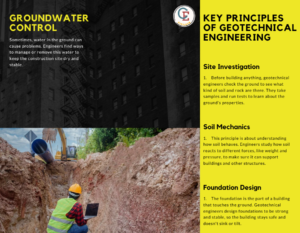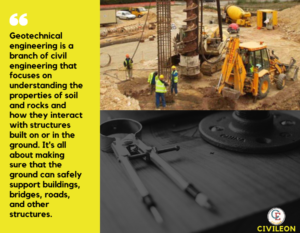What is Geotechnical Engineering?
Geotechnical engineering is a branch of civil engineering that focuses on understanding the properties of soil and rocks and how they interact with structures built on or in the ground. It’s all about making sure that the ground can safely support buildings, bridges, roads, and other structures. Geotechnical engineers study the soil and rock at a construction site to determine if it’s strong and stable enough for what will be built.
They conduct tests, collect samples, and analyze data to design foundations that will hold up under the weight of the structures. They also plan ways to manage groundwater and prevent issues like landslides or sinking buildings. By doing all this, geotechnical engineers help ensure that the structures we use every day are safe, stable, and long-lasting. Their work is essential because even the most well-designed buildings and roads can fail if the ground they sit on is not properly understood and prepared.
Geotech Engineers
Geotechnical engineers are revolutionizing the construction industry by making sure buildings, bridges, and roads are built on strong and stable ground. They use advanced technology to study soil and rock, helping to design safe and sturdy foundations. Their work prevents problems like sinking or collapsing structures.
By understanding the ground better, geotechnical engineers make construction projects safer, more efficient, and more cost-effective. They also help create new ways to build on challenging sites, like soft soil or steep slopes, making it possible to construct in more places. Their expertise is essential for the success and safety of modern construction projects.
Geotechnical engineers are also driving innovation by using new materials and techniques to solve complex ground challenges. They use high-tech tools like drones and ground-penetrating radar to get accurate data about the earth beneath construction sites. They also develop sustainable methods to reduce environmental impact, such as using recycled materials for soil stabilization.
By improving how we manage natural hazards like earthquakes and landslides, geotechnical engineers are making structures more resilient. Their cutting-edge approaches and ongoing research ensure that construction can keep up with the demands of growing cities and changing climates, paving the way for safer and more advanced infrastructure.
Key Principles of Geotechnical Engineering
The principles of geotechnical engineering are the basic ideas that help engineers understand and work with the ground to build safe structures. Here are the main ones, explained in simple words:
Site Investigation: Before building anything, geotechnical engineers check the ground to see what kind of soil and rock are there. They take samples and run tests to learn about the ground’s properties.
Soil Mechanics: This principle is about understanding how soil behaves. Engineers study how soil reacts to different forces, like weight and pressure, to make sure it can support buildings and other structures.
Foundation Design: The foundation is the part of a building that touches the ground. Geotechnical engineers design foundations to be strong and stable, so the building stays safe and doesn’t sink or tilt.
Groundwater Control: Sometimes, water in the ground can cause problems. Engineers find ways to manage or remove this water to keep the construction site dry and stable.
Slope Stability: When building on or near hills, engineers make sure the slopes are stable and won’t slide or collapse. They use special techniques to strengthen the ground and prevent landslides.
Earthquake Engineering: In areas prone to earthquakes, geotechnical engineers design foundations and other structures to withstand shaking and avoid damage.
These principles help geotechnical engineers make sure that buildings, bridges, roads, and other structures are safe and built on solid ground.
Applications of Geotechnical Engineering
Geotechnical engineering has many important applications in construction. Here are some of the key ones explained in very simple words:
Building Foundations: Geotechnical engineers design the part of buildings that sit on the ground, making sure they are strong and stable.
Roads and Highways: They help build roads that won’t crack or sink by studying the soil and making it solid enough to support heavy traffic.
Bridges: They make sure bridge supports are firmly planted in the ground so the bridges are safe and don’t move.
Tunnels: When digging tunnels, geotechnical engineers check the soil and rock to prevent collapses and make sure the tunnel stays open and safe.
Dams: They design and build dams to hold back water, ensuring the ground can support the dam and prevent leaks.
Retaining Walls: These walls hold back soil on steep slopes. Geotechnical engineers design them so they don’t fall over or slide.
Landfills: They plan and design areas for waste disposal, making sure the ground is safe and won’t pollute the environment.
Earthquake Safety: In areas where earthquakes happen, they design buildings and other structures to stay standing and safe during shakes.
Preventing Landslides: They work on hillsides to stop soil from sliding down and causing damage.
Ground Improvement: Sometimes, the soil is too soft or unstable. Geotechnical engineers use different methods to make the ground stronger.
These applications help ensure that structures are safe, stable, and long-lasting by focusing on the ground they are built on.
Case Studies in Geotechnical Engineering
The Leaning Tower of Pisa
The Leaning Tower of Pisa is a well-known case in geotechnical engineering that highlights the importance of understanding soil conditions before construction. When the tower was built in the 12th century, the ground beneath one side was too soft and unstable, causing the tower to start leaning as it rose.
Over the centuries, the tilt increased, threatening the tower’s stability. Geotechnical engineers later studied the soil and foundation, discovering that the uneven settling was due to weak subsoil. To prevent further leaning and potential collapse, they used techniques like soil extraction from underneath the higher side and adding counterweights to stabilize the structure.
This case demonstrates the crucial role of geotechnical engineering in diagnosing and correcting foundation problems, ensuring the safety and preservation of historic landmarks.
The Burj Khalifa
The Burj Khalifa, the world’s tallest building, is a great example of how geotechnical engineering is essential in construction. Before building this enormous skyscraper, geotechnical engineers had to make sure the ground could support its immense weight. They conducted extensive tests on the soil and rock beneath the site to understand their properties.
Because the building is so tall and heavy, they designed deep foundations called piles that go far into the ground to reach solid rock. These piles help distribute the building’s weight evenly and keep it stable. Engineers also made sure the foundations could handle other forces, like wind and seismic activity.
Thanks to the careful work of geotechnical engineers, the Burj Khalifa stands strong and stable, showcasing how important it is to get the ground right before constructing such a massive structure.
Trends in Geotechnical Engineering
As technology advances, geotechnical engineering continues to evolve. Emerging trends include the use of remote sensing and geospatial technologies for site investigations, the application of artificial intelligence in soil analysis, and the development of sustainable construction practices. These innovations promise to enhance the accuracy, efficiency, and environmental sustainability of geotechnical engineering projects.
Advanced Technology: Using drones, sensors, and robots to collect data about the ground quickly and accurately. This helps engineers understand the site better before building.
Sustainable Practices: Finding eco-friendly ways to build, like using recycled materials and reducing waste. This helps protect the environment while constructing new buildings and infrastructure.
Smart Materials: Developing new materials that can change properties based on conditions. These materials can make buildings safer and more adaptable to changes in the environment.
Digital Modeling: Using computer models to simulate how the ground and structures will behave. This helps engineers plan and design more accurately and safely.
Artificial Intelligence (AI): Using AI to analyze data and predict ground behavior. This can help find the best solutions faster and with more precision.
Resilient Design: Creating designs that can withstand natural disasters like earthquakes and floods. This ensures structures remain safe during extreme events.
Remote Sensing: Using satellites and aerial imagery to monitor the ground from afar. This helps in keeping track of large areas and identifying potential problems early.
Underground Construction: Building more underground structures like tunnels and basements to save space above ground, especially in crowded cities.
3D Printing: Using 3D printing technology to create parts of structures. This can speed up construction and reduce costs.
Global Collaboration: Engineers around the world working together, sharing knowledge and techniques to solve common problems and improve standards.
These trends are making geotechnical engineering more advanced, efficient, and sustainable, leading to safer and more innovative construction practices.
Conclusion
Geotechnical engineering is a critical field that ensures the safety and stability of construction projects. By understanding soil and rock properties, designing effective foundations, and mitigating natural hazards, geotechnical engineers play a vital role in shaping our built environment. As technology and knowledge continue to advance, the importance of geotechnical engineering will only grow, paving the way for safer, more resilient structures in the future.
In summary, geotechnical engineering is the backbone of construction, providing the essential groundwork for everything we build. By appreciating the role of geotechnical engineers, we can better understand the complexity and significance of constructing safe and stable structures that stand the test of time.
Feel free to follow us there on Instagram and drop a comment to say hello!



